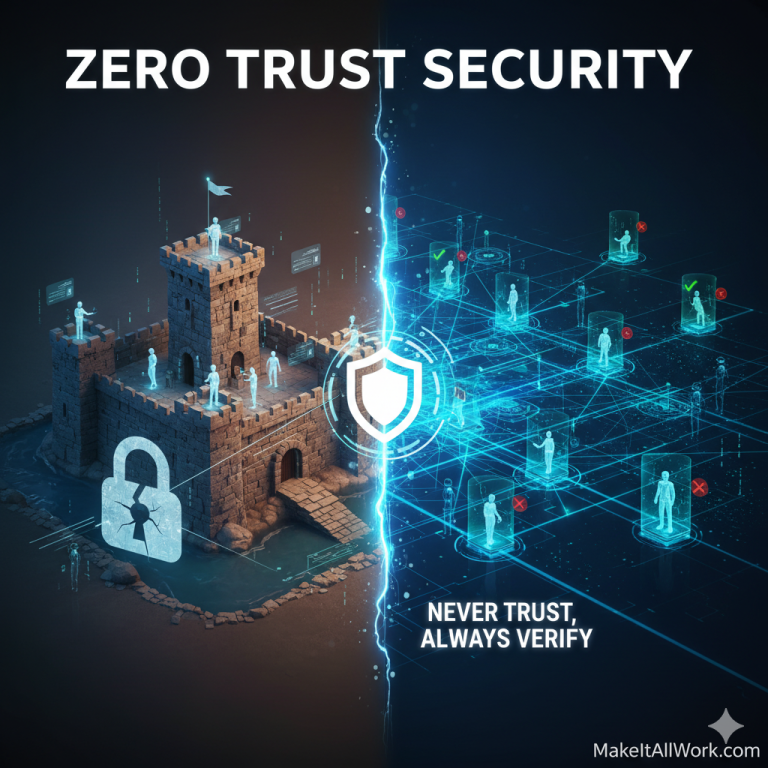Is Your Business Ready for “Never Trust, Always Verify”? Understanding Zero Trust Security

In today’s digital landscape, the idea of a perfectly secure perimeter around your business’s data is, frankly, a fantasy. Cyber threats are more sophisticated than ever, and the old “castle-and-moat” security model simply can’t keep up. That’s where Zero Trust security comes in, a revolutionary approach that assumes no user, device, or application can be implicitly trusted, regardless of their location.
Here at MakeItAllWork.com, we believe understanding Zero Trust isn’t just a good idea – it’s essential for the survival and prosperity of your business. Let’s dive into what Zero Trust means and why it’s becoming the new security mantra.
What exactly is Zero Trust security?
A: At its core, Zero Trust is a security framework that dictates “never trust, always verify.” It means that every single access request to your network, applications, and data must be authenticated, authorized, and continuously validated, regardless of where the request originates from or what resource it’s trying to access.
Think of it this way: In a traditional “castle-and-moat” model, once you’re inside the castle walls, you’re largely trusted. With Zero Trust, it’s like every room in the castle requires a new keycard, biometric scan, and a check of your credentials every time you want to enter, even if you just came from the next room.
How does Zero Trust differ from traditional security models (the “castle-and-moat”)?
A: The “castle-and-moat” model focuses on building strong defenses around a network perimeter. Once an entity (user or device) has breached that perimeter and gained access, it’s generally assumed to be trustworthy within the network. This approach worked better when all business operations happened within a physical office and threats were primarily external.
However, the rise of cloud computing, remote work, and mobile devices has shattered that perimeter. Data is everywhere, and users are accessing resources from myriad locations. The “castle-and-moat” leaves internal network activities largely unchecked, making it vulnerable to insider threats or once an external attacker manages to get past the initial defenses. Zero Trust, conversely, treats every access attempt as if it’s coming from an untrusted network segment, demanding rigorous verification at every step.
Why is the “castle-and-moat” approach obsolete?
A: Several factors have rendered the traditional model ineffective:
- Blurred Perimeters: With cloud applications (SaaS), remote work, and bring-your-own-device (BYOD) policies, the “perimeter” of your network is no longer a clearly defined boundary.
- Sophisticated Threats: Modern cyberattacks, like phishing, ransomware, and advanced persistent threats (APTs), often aim to gain a foothold inside the network, where traditional defenses are weaker.
- Insider Threats: Malicious or negligent insiders can pose significant risks. The “castle-and-moat” often gives too much implicit trust to internal users.
- Lateral Movement: If an attacker breaches the perimeter, they can often move freely (“lateral movement”) across the internal network to find valuable data. Zero Trust aims to prevent this.
What are the core principles of a Zero Trust architecture?
A: While implementation can vary, the fundamental principles remain constant:
- Verify Explicitly: All access requests must be authenticated and authorized based on all available data points, including user identity, location, device health, service or workload, data sensitivity, and behavioral anomalies.
- Use Least Privilege Access: Users and devices should only be granted access to the specific resources they need for a specific task, for a limited time. This minimizes the potential damage if an account is compromised.
- Assume Breach: Always operate under the assumption that a breach has already occurred or is imminent. This mindset drives continuous monitoring, detection, and response capabilities.
- Microsegmentation: Break down your network into smaller, isolated segments. This limits lateral movement for attackers, as even if one segment is compromised, they can’t easily jump to another.
- Multi-Factor Authentication (MFA): Require more than just a password for verification.
- Device Health & Compliance: Ensure devices accessing your resources are healthy, up-to-date, and comply with security policies.
- Continuous Monitoring & Validation: Security is an ongoing process. Continuously monitor network traffic, user behavior, and system activity to detect and respond to threats in real-time.
What are the benefits of implementing Zero Trust?
A: Adopting a Zero Trust framework offers significant advantages:
- Enhanced Security Posture: Reduces the attack surface and significantly limits the damage from breaches.
- Better Data Protection: Safeguards sensitive data by controlling access more granularly.
- Improved Compliance: Helps meet regulatory requirements by enforcing strict access controls and audit trails.
- Support for Remote Work: Securely enables employees to work from anywhere on any device.
- Reduced Risk of Lateral Movement: Makes it harder for attackers to spread through your network once they gain initial access.
- Increased Visibility: Provides a clearer understanding of who is accessing what, when, and from where.
Is Zero Trust only for large enterprises?
A: Absolutely not! While large enterprises often have complex needs that make Zero Trust highly beneficial, small and medium-sized businesses (SMBs) are often more vulnerable to cyberattacks and have fewer resources to recover. Implementing Zero Trust principles can significantly bolster an SMB’s defenses without necessarily requiring an overhaul of every single system overnight. Starting with MFA, least privilege, and device health checks can be powerful initial steps.
Ready to Fortify Your Business’s Digital Defenses?
The “never trust, always verify” mantra isn’t just a catchy phrase; it’s a fundamental shift in cybersecurity thinking that your business needs to embrace. Ignoring it leaves you exposed to an ever-evolving landscape of threats.
At MakeItAllWork.com, we specialize in helping businesses like yours navigate the complexities of modern IT security. Whether you’re just starting to explore Zero Trust or need help implementing a comprehensive strategy, we’re here to ensure your digital assets are protected.
Don’t wait for a breach to happen. Contact MakeItAllWork today for a consultation on how Zero Trust can secure your future.

 ALL BLOGS
ALL BLOGS


